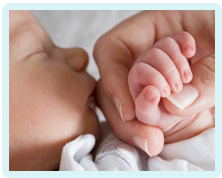
Instrumental Delivery and Perineal Tears
Research suggests that an instrumental delivery is a risk factor in suffering a severe perineal tear during the birth of your baby.
What is an instrumental delivery?
An instrumental delivery may be necessary if it is proving difficult for the baby to be born. If labour has been protracted, the mother may be becoming weak and finding it hard to keep pushing.
This could be because the baby is large or is in an awkward position inside the mother or has become stuck.
In these circumstances, the obstetrician may decide that the mother needs assistance in delivering her baby and will choose to use forceps or a ventouse.
Unfortunately, the circumstances that may require an instrumental delivery - a large baby or a stuck baby - are also those circumstances which may make a severe perineal tear more likely.
What is a ventouse?
A ventouse is a suction cap which is applied to the top of the baby's head and pulled gently as the mother pushes, in the hope that the additional assistance will ease the passage of the baby out of the vagina.
What are forceps?
Forceps are a medical instrument similar to a large pair of tongs which are placed on the sides of the baby's head and used, like a ventouse, to help pull the baby out when the mother pushes.
Forceps, ventouse and severe tears
However, the use of a ventouse, or particularly forceps, during childbirth increases the chances that the mother will experience a severe tear.
Most women suffer a perineal tear around the vagina of some degree but some women, approximately 5%, will suffer a severe tear which cuts across the perineum and additionally damages the muscles that control the anus.
It is believed that the additional pressure which a ventouse or forceps puts on the skin and muscle around the vagina may increase the mother's chance of receiving a third or fourth degree tear.
Instrumental delivery and an episiotomy
It is possible that a woman undergoing an instrumental delivery of her baby may also be given an episiotomy - a deliberate, surgical cut to the perineum between the vagina and the anus - to ease the use of the ventouse or forceps. There is some suggestion that the mother is less likely to suffer a severe tear with an instrumental delivery if she has already been given an episiotomy.
Equally, there is conflicting evidence as to the role of episiotomies in the experience of severe perineal tears with some suggestion that they can make a third or fourth degree tear more likely.
Monitoring an instrumental delivery
If it proves necessary to use either a ventouse or forceps in the course of a birth, the mother should be thoroughly examined afterwards to ensure that she has not received a severe perineal tear.
If she has, in fact, received a third or fourth degree tear, she will need to be taken to an operating theatre for her injury to be repaired by an experienced surgeon.
Medical Negligence
If a severe tear is not diagnosed accurately and repaired effectively, the mother may suffer appalling long-term symptoms. In these circumstances, it may be appropriate to make a claim for compensation for the substandard level of care received.
Speak to a solicitor
Glynns Solicitors are specialists in medical negligence and have supported numerous claims for compensation due to poorly-treated perineal tears. Contact us to discuss your experience.
Please call us on 0800 234 3300 (or from a mobile 01275 334030) or complete our Online Enquiry Form.



